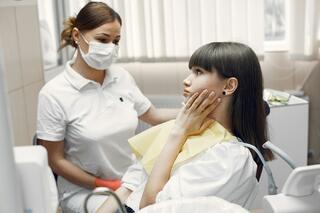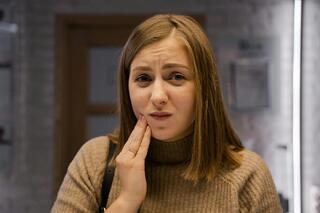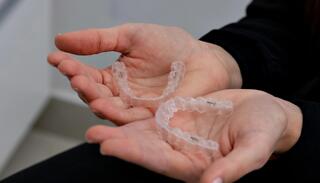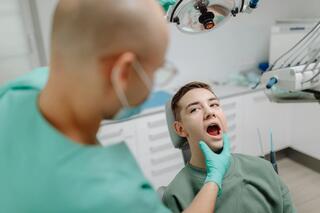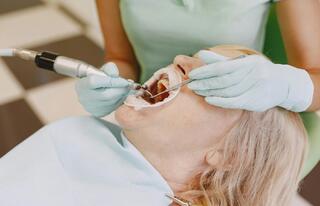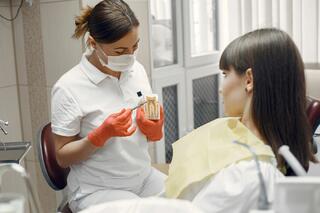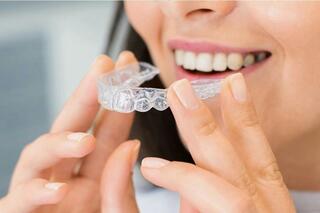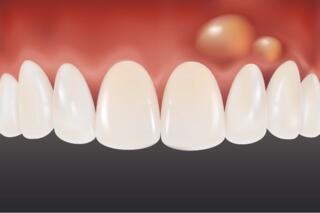What is Bruxism (Teeth grinding)?
Bruxism (Teeth grinding) is the involuntary contraction of the chewing muscles, leading to strong jaw clenching and teeth grinding. This phenomenon is associated with muscle spasms and often accompanied by the sound of grinding, especially during sleep. Most people learn about their bruxism from close relatives.
Bruxism can have various causes. Diagnosis and treatment require a comprehensive approach. Uncontrolled teeth clenching is not just a physiological feature. It is a serious issue that can lead to complications and requires medical intervention.
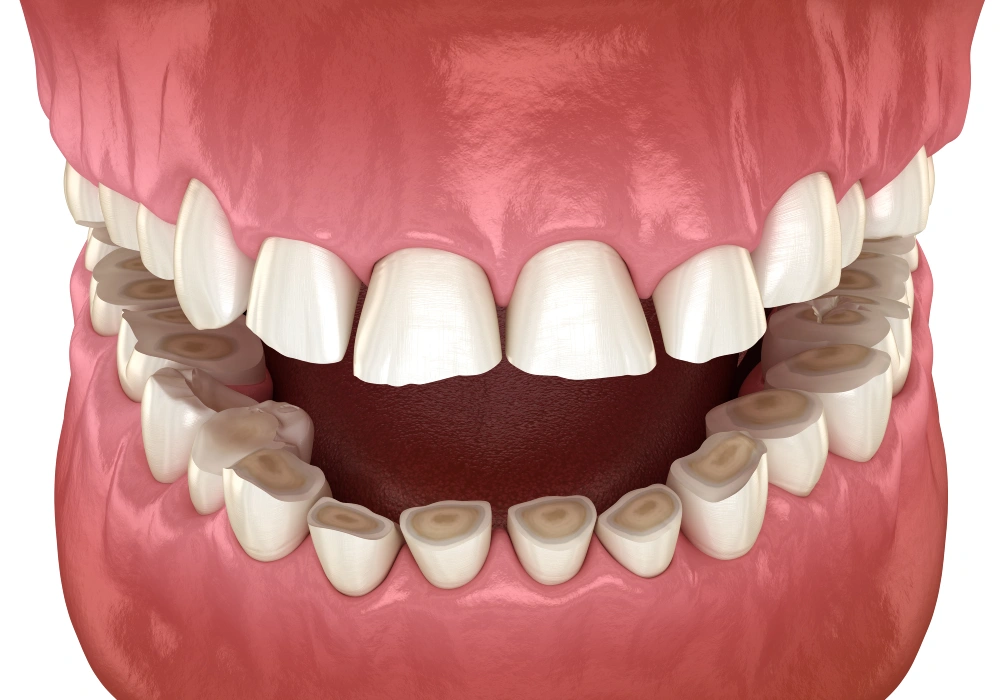
Symptoms of Bruxism
Bruxism most often manifests as involuntary jaw clenching during sleep, making it difficult to notice on your own. Typically, family members hear the characteristic teeth grinding and bring it to attention.
- Gum recession.
- Waking up with clenched teeth.
- Pain in the jaw joints and facial muscles.
- Increased tooth sensitivity to heat, cold, and sweets.
- Reduction in tooth height or wear.
- Headaches due to poor sleep.
- Chips, cracks, and loss of fillings.
- Tension in the lower part of the face.
About 15-20% of adults and 30-40% of children suffer from bruxism in some form. This condition can negatively impact health and quality of life. Doctors recommend seeking medical help at early stages. A thorough assessment, identifying the cause, and developing a treatment plan are important.
Types of Bruxism
-
Daytime Bruxism
Teeth clenching during wakefulness due to stress or anxiety. -
Nighttime Bruxism
Involuntary jaw movements during sleep, sometimes accompanied by snoring and apnea.
Bruxism is classified by the type of jaw movements:
- Tapping.
- Grinding – lateral or crosswise movement.
- Clenching – in a front-to-back direction.
Daytime bruxism occurs during the day when a person is awake. The person involuntarily clenches their teeth and is aware of it but cannot control the process. It often arises from stress or mental strain, causing discomfort and tension in the facial muscles. Nighttime bruxism occurs during sleep, and the person is not aware of this condition. It can lead to jaw pain, headaches, and damage to the teeth.
Both types of bruxism have different causes and require different treatment approaches. Doctors determine the best treatment method after a thorough diagnosis.
Causes of Bruxism
Bruxism is associated with disorders in various body systems.
Dental Causes
These include abnormalities in the structure and function of the dental-maxillary system. Normal jaw closure is difficult. The body tries to correct this by clenching the jaws.
Clinical studies have shown that bruxism can be caused by occlusal disharmony due to:
- incorrect bite (abnormal tooth positioning);
- partial tooth loss;
- fillings, crowns, or bridges of incorrect anatomical shape;
- uneven pathological tooth wear;
- gaps in the dental arch or supernumerary teeth;
- problems with the TMJ (temporomandibular joint dysfunction).
When the bite is disturbed, the jaws cannot find a resting point. The facial muscles try to adapt to the pathological jaw closure, leading to involuntary movements.
It has been scientifically proven that bruxism can be inherited.
Psychological Causes
These include aspects of the psychoemotional state, such as prolonged stress, mental overload, depression. Perceiving situations as stressful, constant worry, or nerve strain can cause unconscious contractions of the facial muscles and teeth grinding. Uncontrolled spasms of the chewing muscles can be a reaction to psychological stress.
Neurological Causes
Disorders in the central or peripheral nervous system and motor disturbances can lead to involuntary jaw clenching. Bruxism is often accompanied by snoring, nocturnal apnea, epilepsy, and other neurological disorders. It can also occur with trigeminal neuralgia, cervical osteochondrosis or parkinson's disease. Treating these conditions can alleviate the symptoms.
Osteopathic Causes of Bruxism
Abnormalities in the structure or function of the bones and tissues of the facial and cranial areas can lead to involuntary teeth grinding. The body tries to restore balance by activating neuromuscular mechanisms, leading to teeth grinding.
The constant clenching of teeth leads to an enhancement of the chewing muscles. This can alter the shape of the face, making it appear more tense and square. An incorrect bite can cause an aging effect on the face – the height of the lower third of the face decreases.
Risk Factors
Factors contributing to the development of bruxism include:
- Chronic anxiety;
- Excessive caffeine intake;
- Smoking, alcohol consumption;
- Regular use of antidepressants or neuroleptics (teeth grinding can be a side effect);
- Parkinson's disease.
Complications of Bruxism
Untreated bruxism can lead to various complications:
- Severe tooth wear. Constant clenching leads to enamel erosion, cracks, chipping, and loss of fillings. Increased tooth sensitivity to temperature, development of cavities, and pulpitis occur. The bite is disrupted, possibly leading to facial asymmetry.
- Periodontitis. Develops due to constant trauma to the tissues around the teeth. Teeth can become loose and fall out.
- Cervical osteoarthritis. Often involves the spine, leading to posture changes.
- Temporomandibular joint dysfunction. Constant tension in the chewing muscles causes an imbalance. Opening and closing the jaw is difficult and painful. Pain in the neck, ears, and back of the head. The jaw joints do not function properly, with clicking sounds during eating and yawning. The jaw can become stuck.
- Sleep disturbances. Involuntary clenching of the jaw at night disrupts normal sleep, causing drowsiness and daytime fatigue. Affects psychological well-being.
- Injuries in the oral cavity. Abrasions and ulcers can develop on the inside of the cheeks. Causes pain and discomfort in the mouth. Injuries to the mucous membrane can lead to infections. Stomatitis and gingivitis may develop.
- Hypertrophy of the facial muscles. Constant overexertion of the chewing muscles leads to their deformation. The appearance of the face changes, acquiring an asymmetrical shape.
When to See a Doctor?
Bruxism cannot be treated at home. If you suspect signs of bruxism, consult a gnathologist or an orthodontic dentist. Timely medical attention minimizes side effects on the teeth.

Reasons to see a doctor:
- Teeth have become sensitive to temperature and touch.
- Feeling of sand or foreign particles in the mouth.
- Decreased tooth height, appearance of sharp edges.
- Changes in smile, face shape, and contour.
- Pain in the jaw joints, tension in the facial muscles.
- Widening gaps between teeth, chips, cracks.
Diagnosis of Bruxism by Doctors
- Medical history collection. Doctors examine the face, jaws, and teeth. They ask about symptoms and medical history. They assess the extent of the pathology and its impact on the teeth. They check the bite, jaw closure, and the condition of fillings or crowns. Patients complete a questionnaire about their emotional state and psychological factors contributing to teeth grinding.
- Radiological examination. A panoramic image shows the condition of the teeth, jaws, and joints. Doctors determine the degree of wear, changes in the bite, and structural anomalies. Computer tomography provides detailed three-dimensional images of the dental-maxillary system.
- Use of brux-checkers. Dentists create individual splints based on an impression of the patient's jaw. The patient wears them at night. A special dye on the splints indicates areas where the teeth close with excessive force or pathologically.
Instrumental examination methods
- Electromyography measures the electrical activity of the chewing muscles. Electrodes are placed in this area. The patient performs various jaw movements. Muscle activity at rest and during contraction is recorded. The data is analyzed to identify anomalies and pathological changes.
- Gnathodynamometer measures the force a person applies when closing the jaws or chewing. The results can provide information about disorders in the function of the jaws and chewing muscles and help make an accurate diagnosis.
- Polysomnography is conducted in specialized sleep laboratories. It assesses sleep quality and helps identify the cause and nature of sleep disturbances. This is important for developing a treatment plan.
Treatment of Bruxism
Effective bruxism management includes various approaches: from dental therapy to stress and anxiety management strategies. It depends on the causes and nature of the disease and is conducted under the supervision of qualified medical professionals.
Treatment Methods:
1. Tooth protection – making a custom-fitted flexible splint worn at night. It prevents enamel wear, relaxes the chewing muscles, improves sleep, and reduces jaw and headache pain.
2. Addressing the cause:
- Dentists adjust the tooth surfaces for a correct bite and eliminate uneven contacts.
- Use of TENS therapy, splint therapy, or botulinum toxin therapy to relax the chewing muscles, normalize the function of the temporomandibular joint, and alleviate pain.
- Facial muscle massage and physical exercises for relaxation can improve the condition of the jaw.
- Medication treatment includes taking sleeping pills, muscle relaxants, magnesium, calcium, and B-group vitamins. Consultations with a psychotherapist or psychologist for stress management.
3. Treating the consequences – restoring teeth with fillings, crowns, veneers, bridge prostheses. Implants with prostheses are used in case of tooth loss. Bite correction with braces or aligners.
Easing Bruxism Before Treatment
- Avoid smoking, alcohol, and excessive coffee consumption.
- Take magnesium and calcium to reduce facial muscle spasms (only as prescribed by a doctor).
- Learn to control anxiety and relax (listen to music, go for walks, exercise).
- Follow the rules of healthy sleep (without medication).
- Wear protective splints at night to protect your teeth from injuries during unconscious teeth grinding.
Preventive Measures
- Use relaxation methods and breathing exercises to reduce stress and anxiety.
- Reduce caffeine, alcohol, and nicotine consumption, especially before bedtime.
- Increase the intake of vegetables, fruits, and healthy proteins. Your diet should be balanced.
- Ensure regular and quality sleep. Avoid heavy meals in the evening.
- Avoid harmful habits, such as chewing pencils.
- Regularly visit the dentist for timely treatment of teeth and gums. Do not delay replacing missing teeth.
- If you experience symptoms of involuntary clenching, seek medical advice and assessment of your condition. The earlier, the easier it is to control and treat the pathology and its consequences.
Frequently Asked Questions
Is bruxism harmful?
Occasional teeth grinding or jaw clenching can be harmful. Frequent grinding can lead to serious health issues. These include dental problems, jaw pain, headaches, migraines, TMJ disorders, and even issues like tinnitus and dizziness.
How does bruxism affect oral health?
Frequent teeth grinding can lead to cracked or loose teeth, tooth loss, jaw pain, TMJ disorders, muscle tension, sleep disturbances, and enamel wear.
How is bruxism treated?
Treatment options include splints, botox injections, biofeedback training, medication, stress management, and lifestyle changes. Combined treatment methods often prove more effective.
Can bruxism be prevented?
Managing stress and anxiety, learning not to clench the jaw, avoiding chewing non-food items, limiting alcohol and caffeine can help prevent bruxism. Regular dental check-ups are also important for early detection.
How does bruxism affect children?
Bruxism is more common in children but often resolves as they grow. Causes in children can include allergies, improper teeth alignment, and obstructive sleep apnea.
Are splints effective for bruxism?
Custom-made splints can protect teeth from damage caused by grinding, but they do not stop bruxism itself. Over-the-counter splints may not be as effective.
What role does Botox play in treating bruxism?
Botox injections into the jaw muscles can reduce muscle contractions, relieving tension and symptoms of bruxism. The effect is temporary, usually lasting 3-6 months, and the procedure has a high success rate with minimal side effects.
